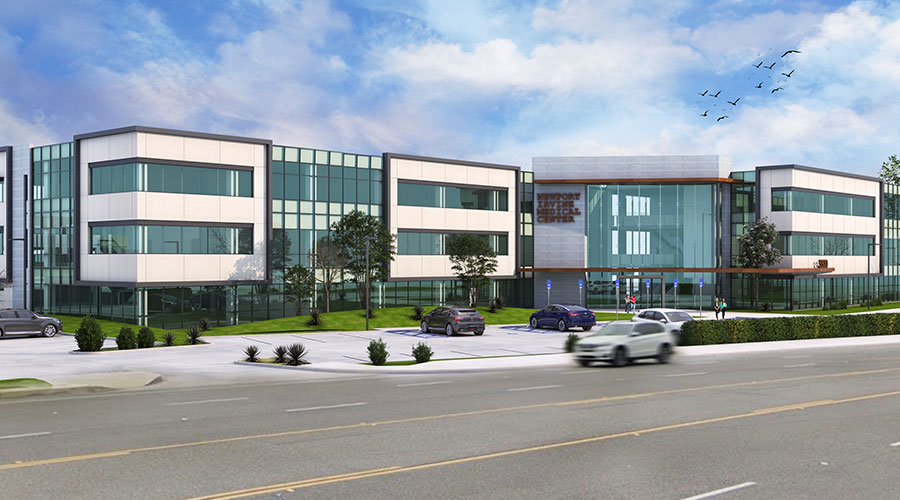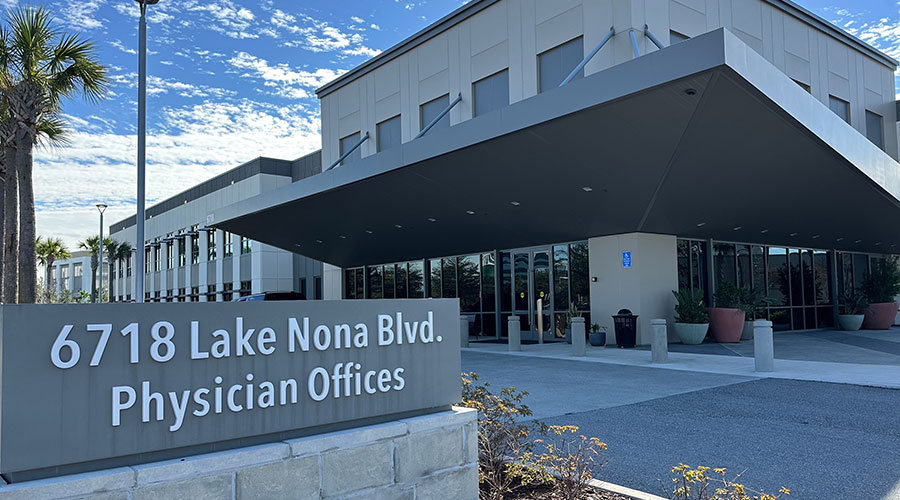Architect Peter Baldwin had a strange day at work. He was designing the perfect ophthalmology exam room, which is not so strange for Peter. Peter has designed many medical clinics. However, he was accustomed to listening to the needs of the physicians and clinic managers, and then creating a design in the quiet of his own office. But today he was gathered around a conference table with ophthalmic technicians, the people on the ‘front lines.’ Two teams of techs were building the perfect exam room in a friendly competition, before Peter’s eyes.
This was obviously not going to be an ordinary space planning process. And it did not lead to an ordinary space.
Growth creates opportunity
The Grand Rapids, Michigan ophthalmology practice founded by Dr. Thomas Aaberg and co-owned by Dr. Scott Westhouse had outgrown its previous clinic space, and they determined that a new building was the best option. Dr. Aaberg wanted to make sure that the move was an opportunity not only for a new space, but for an improved process as well. He engaged Aneesh Suneja, Lean expert and president of FlowOne Lean Consulting. “We needed an innovative medical office that balanced the needs of the business with the needs of the patients. Most traditional offices don’t do this well,” Aaberg said.
Dr Aaberg recognized that the current process in his clinic was fragmented and inefficient. Patients had long wait times, often spending two or three hours in the clinic for less than 10 minutes of his time. Because of the clinic layout and room utilization, the care process involved excessive walking for staff and patients alike, and created opportunities for missed handoffs and poor communication. Physicians were tired and frustrated, often working late to catch up on EMR documentation which added three to six minutes per patient—up to two to four hours of additional work each clinic day.
Fragmented care and communication barriers are two of the biggest hurdles to patient satisfaction that healthcare organizations face, according to a new poll of U.S. health care quality improvement professionals conducted by ASQ, the world’s largest network of quality resources and experts.
A fragmented process consumes more resources than a Lean one and over half of healthcare quality experts surveyed by ASQ believe that Lean offers the best potential for helping improve patient experience. In the clinic’s case, the separation of the tech’s rooms for working up patients and the exam rooms for the physician’s consultation meant that two sets of resources had to be available to move the patient to the next process step. Coordinating those two sets of resources proved to be a challenge, as techs could not always find each other, nor did they have an easy, visual way to tell which exam rooms were free and when.
Building lean principles into the design process
To facilitate the design, Suneja did something that is seldom done in architectural planning: he asked Peter Baldwin to become a member of a lean design team comprised mostly of the front line staff. According to Suneja, “The front line team— technicians, nurses, medical assistants — they are the ones with the intimate knowledge of how the process works and doesn’t work, and where the problems exist.” As the team mapped their movements and the patient flow, they found that both they and the patient were spending more time walking than they had imagined. In one design meeting, Peter was asked to be a pretend patient in a simulation in the existing clinic space, to intimately understand the current patient experience and the challenges in flow. The efforts paid off as the main design issues surfaced and the whole team gained insights into the specific space needs of the practice.
Armed with a thorough understanding of their own care process and knowledge of Lean principles, the team realized how the design of the space would impact not only their ability to provide efficient care, but the quality of the patient experience as well. They decided on some key goals for the design of the new facility: create a common workspace for the whole team to improve communication, eliminate excess walking for patients and staff, and help make more efficient use of the physicians’ time.
The result of the team’s work was a design for the new facility that met the clinic’s needs exactly. The central design feature is a “hub-and-spokes” layout for the common workroom and flexible treatment rooms. The common workroom co-locates physicians and technicians in a workspace. In this model, the technicians do not have to walk up and down hallways to figure out which room the doctor is in or which patient is ready for the next step. Doors from this common workroom open into the exam rooms, which are the “spokes” in the hub-and-spokes model. Patients enter the exam rooms from a separate, quiet hallway.
The exam rooms went from single purpose rooms to flexible rooms that could serve both as tech work-up rooms and physician consultation rooms. Any patient could be seen in any room, and the new layout meant that once roomed the patient stayed put, eliminating the excess patient trips to the waiting room that occurred in the previous process. As the delays were systematically removed from the process, room utilization increased. This meant that even as the practice grew, the number of flexible exam rooms needed actually decreased from six to five, for each physician.
The exam rooms were designed with space for a scribe to accompany the physician during the patient consultation. That space in the room enabled a process in which the technician—acting as a scribe—could document notes in the EMR system in real time, making sure that the notes are accurate and complete, while freeing up physician’s concentration and time to communicate with the patient. The team also thought about supplies placement, patient and physician entry and exit, and maximizing eye contact during the consultation in their design of the exam rooms.
Design translates into results
The combination of process changes supported by space design yielded great results for the practice. Wait times fell by 74%, as patients who once spent two or three hours in the clinic are now spending fewer than 60 minutes. The distance that new patients walk decreased by 65 steps, and patient satisfaction score improved 15%. The physicians gained between 30 and 45 minutes of productivity in each clinic session, which creates the capacity for three to five additional patients each day.
After the first day of seeing patients in the new space, Dr. Scott Westhouse noticed a dramatic difference. “The space looks great, and more importantly it feels great! The central hub workspace for doctors and technicians accomplished its purpose. It felt Lean and enhanced our workflow. Staff satisfaction and patient satisfaction after only one morning in this environment was a palpable improvement.”
For architect Peter Baldwin, the design “confirmed my belief that space matters. By that, I mean its ability to change the trajectory, to change what’s happening in that space—to shape the patient experience and change the how the team is able to work.”
Aneesh Suneja is the president and founder of FlowOne Lean Consulting LLC, based just outside Milwaukee, Wis., and the co-author, with his wife, Carolyn Suneja, of Lean Doctors: A Bold and Practical Guide to Using Lean Principles to Transform Healthcare Systems, One Doctor at a Time. This article was prepared in consultation with Dr. Thomas M. Aaberg, Jr., Founder of Retina Specialists of Michigan, Scott J. Westhouse, D.O., Co-Owner of Retina Specialists of Michigan, Peter Baldwin, President of AMDG Architects, Inc. based in Grand Rapids, Michigan and Craig Baker, Vice President of First Companies, Inc. based in Grand Rapids, Michigan

 States Move Forward to Better Protect Senior Citizens
States Move Forward to Better Protect Senior Citizens Archer and REDA to Transform Newport Beach Building into Outpatient Center
Archer and REDA to Transform Newport Beach Building into Outpatient Center Sunflower Medical Group Facing Lawsuit Following January Data Breach
Sunflower Medical Group Facing Lawsuit Following January Data Breach Nemours Children's Health Opens New Location in Lake Nona
Nemours Children's Health Opens New Location in Lake Nona Enhancing Safety at Hennepin Healthcare with a Screening System
Enhancing Safety at Hennepin Healthcare with a Screening System